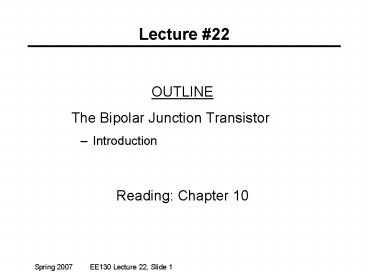OUTLINE - PowerPoint PPT Presentation
1 / 6
Title:
OUTLINE
Description:
Lecture #22 OUTLINE The Bipolar Junction Transistor Introduction Reading: Chapter 10 Bipolar Junction Transistors (BJTs) Introduction Charge Transport in a BJT ... – PowerPoint PPT presentation
Number of Views:202
Avg rating:3.0/5.0
Title: OUTLINE
1
Lecture 22
- OUTLINE
- The Bipolar Junction Transistor
- Introduction
- Reading Chapter 10
2
Bipolar Junction Transistors (BJTs)
- Over the past 3 decades, the higher layout
density and low-power advantage of CMOS
technology has eroded away the BJTs dominance in
integrated-circuit products. - (higher circuit density ? better system
performance) - BJTs are still preferred in some digital-circuit
and analog-circuit applications because of their
high speed and superior gain. - faster circuit speed
- larger power dissipation
- ? limits integration level to 104 circuits/chip
3
Introduction
- The BJT is a 3-terminal device
- 2 types PNP and NPN
VEB VE VB VCB VC VB VEC VE VC
VEB - VCB
VBE VB VE VBC VB VC VCE VC VE
VCB - VEB
- The convention used in the textbook does not
follow IEEE convention (currents defined as
positive flowing into a terminal) - We will follow the convention used in the textbook
4
Charge Transport in a BJT
- Consider a reverse-biased pn junction
- Reverse saturation current depends on rate of
minority-carrier generation near the junction - can increase reverse current by increasing rate
of minority-carrier generation - Optical excitation of carriers
- Electrical injection of minority carriers into
the neighborhood of the junction
5
PNP BJT Operation (Qualitative)
Active Bias VEB gt 0 (forward bias), VCB lt 0
(reverse bias)
ICn
Collector
Emitter
Base
ICp
6
BJT Design
- Important features of a good transistor
- Injected minority carriers do not recombine in
the neutral base region - Emitter current is comprised almost entirely of
carriers injected into the base (rather than
carriers injected into the emitter

